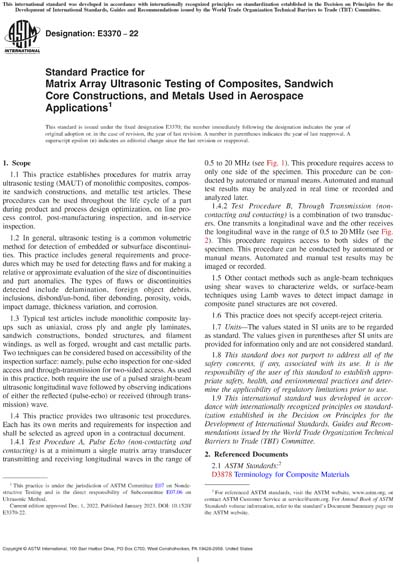Historical
ASTM E3370-22
Standard Practice for Matrix Array Ultrasonic Testing of Composites, Sandwich Core Constructions, and Metals Used in Aerospace Applications
1.1This practice establishes procedures for matrix array ultrasonic testing (MAUT) of monolithic composites, composite sandwich constructions, and metallic test articles. These procedures can be used throughout the life cycle of a part during product and process design optimization, on line process control, post-manufacturing inspection, and in-service inspection.
1.2In general, ultrasonic testing is a common volumetric method for detection of embedded or subsurface discontinuities. This practice includes general requirements and procedures which may be used for detecting flaws and for making a relative or approximate evaluation of the size of discontinuities and part anomalies. The types of flaws or discontinuities detected include delamination, foreign object debris, inclusions, disbond/un-bond, fiber debonding, porosity, voids, impact damage, thickness variation, and corrosion.
1.3Typical test articles include monolithic composite lay-ups such as uniaxial, cross ply and angle ply laminates, sandwich constructions, bonded structures, and filament windings, as well as forged, wrought and cast metallic parts. Two techniques can be considered based on accessibility of the inspection surface: namely, pulse echo inspection for one-sided access and through-transmission for two-sided access. As used in this practice, both require the use of a pulsed straight-beam ultrasonic longitudinal wave followed by observing indications of either the reflected (pulse-echo) or received (through transmission) wave.
1.4This practice provides two ultrasonic test procedures. Each has its own merits and requirements for inspection and shall be selected as agreed upon in a contractual document.
1.4.1Test Procedure A, Pulse Echo (non-contacting and contacting)is at a minimum a single matrix array transducer transmitting and receiving longitudinal waves in the range of 0.5 to 20 MHz (see Fig. 1). This procedure requires access to only one side of the specimen. This procedure can be conducted by automated or manual means. Automated and manual test results may be analyzed in real time or recorded and analyzed later.
FIG. 1Test Procedure A, Pulse Echo Apparatus Set-up for a Composite Panel (Left) and Metal Plate (Right) Using One-sided Access


1.4.2Test Procedure B, Through Transmission (non-contacting and contacting)is a combination of two transducers. One transmits a longitudinal wave and the other receives the longitudinal wave in the range of 0.5 to 20 MHz (see Fig. 2). This procedure requires access to both sides of the specimen. This procedure can be conducted by automated or manual means. Automated and manual test results may be imaged or recorded.
FIG. 2Test Procedure B, Through Transmission Apparatus Set-up using Two-sided Access


1.5Other contact methods such as angle-beam techniques using shear waves to characterize welds, or surface-beam techniques using Lamb waves to detect impact damage in composite panel structures are not covered.
1.6This practice does not specify accept-reject criteria.
1.7Units - The values stated in SI units are to be regarded as standard. The values given in parentheses after SI units are provided for information only and are not considered standard.
1.8This standard does not purport to address all of the safety concerns, if any, associated with its use. It is the responsibility of the user of this standard to establish appropriate safety, health, and environmental practices and determine the applicability of regulatory limitations prior to use.
1.9This international standard was developed in accordance with internationally recognized principles on standardization established in the Decision on Principles for the Development of International Standards, Guides and Recommendations issued by the World Trade Organization Technical Barriers to Trade (TBT) Committee.
Content Provider
ASTM International [astm]






